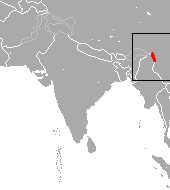Lutung samotny
Lutung samotny[5] (Trachypithecus shortridgei) – gatunek ssaka naczelnego z podrodziny gerez (Colobinae) w obrębie rodziny koczkodanowatych (Cercopithecidae).
| Trachypithecus shortridgei[1] | |||
| (Wroughton, 1915) | |||

| |||
| Systematyka | |||
| Domena | |||
|---|---|---|---|
| Królestwo | |||
| Typ | |||
| Gromada | |||
| Rząd | |||
| Podrząd | |||
| Infrarząd | |||
| Parvordo | |||
| Nadrodzina | |||
| Rodzina | |||
| Podrodzina | |||
| Plemię | |||
| Rodzaj | |||
| Gatunek |
lutung samotny | ||
| Synonimy | |||
|
| |||
| Kategoria zagrożenia (CKGZ)[4] | |||
 | |||
| Zasięg występowania | |||

| |||
Zasięg występowania
edytujLutung samotny występuje w północno-wschodniej Mjanmie, na wschód od rzeki Czinduin (stan Kaczin na północ od dystryktu Myitkyina) i południowo-zachodniej Chińskiej Republice Ludowej (dolina rzeki Dulong w powiecie Gongshan, północno-zachodni Junnan)[6].
Taksonomia
edytujGatunek po raz pierwszy naukowo opisał w 1915 roku brytyjsko-indyjski zoolog Robert Charles Wroughton nadając mu nazwę Presbytis shortridgei[2]. Holotyp pochodził z Homalin, w górnym biegu rzeki Chindwin, w Mjanmie[7].
T. shortridgei należy do grupy gatunkowej pileatus[6]. W górnym biegu rzeki Chindwin może występować intergradacja z T. pileatus lub nieopisana odmiana T. shortridgei[6]. Autorzy Illustrated Checklist of the Mammals of the World uznają ten takson za gatunek monotypowy[6].
Etymologia
edytujMorfologia
edytujDługość ciała (bez ogona) 67–72 cm, długość ogona 95–104 cm; brak szczegółowych danych dotyczących masy ciała[10].
Przypisy
edytuj- ↑ Trachypithecus shortridgei, [w:] Integrated Taxonomic Information System (ang.).
- ↑ a b Wroughton 1915 ↓, s. 56.
- ↑ Wroughton 1915 ↓, s. 57.
- ↑ Y. Long & S. Htun, Trachypithecus shortridgei, [w:] The IUCN Red List of Threatened Species 2020, wersja 2021-2 [dostęp 2021-09-12] (ang.).
- ↑ Nazwy polskie za: W. Cichocki, A. Ważna, J. Cichocki, E. Rajska-Jurgiel, A. Jasiński & W. Bogdanowicz: Polskie nazewnictwo ssaków świata. Warszawa: Muzeum i Instytut Zoologii PAN, 2015, s. 53. ISBN 978-83-88147-15-9. (pol. • ang.).
- ↑ a b c d C.J. Burgin, D.E. Wilson, R.A. Mittermeier, A.B. Rylands, T.E. Lacher & W. Sechrest: Illustrated Checklist of the Mammals of the World. Cz. 1: Monotremata to Rodentia. Barcelona: Lynx Edicions, 2020, s. 258. ISBN 978-84-16728-34-3. (ang.).
- ↑ D.E. Wilson & D.M. Reeder (redaktorzy): Species Trachypithecus (Trachypithecus) shortridgei. [w:] Mammal Species of the World. A Taxonomic and Geographic Reference (Wyd. 3) [on-line]. Johns Hopkins University Press, 2005. [dostęp 2021-09-12].
- ↑ T.S. Palmer. Index Generum Mammalium: a List of the Genera and Families of Mammals. „North American Fauna”. 23, s. 683, 1904. (ang.).
- ↑ B. Beolens, M. Watkins & M. Grayson: The Eponym Dictionary of Mammals. Baltimore: The Johns Hopkins University Press, 2009, s. 378–379. ISBN 978-0-8018-9304-9. (ang.).
- ↑ D. Zinner, G.H. Fickenscher, Ch. Roos, M.V. Anandam, E.L. Bennett, T.R.B. Davenport, N.J. Davies, K.M. Detwiler, A. Engelhardt, A.A. Eudey, E.L. Gadsby, C.P. Groves, A. Healy, K.P. Karanth, S. Molur, T. Nadler, M.C. Richardson, E.P. Riley, A.B. Rylands, L.K. Sheeran, N. Ting, J. Wallis, S.S. Waters & D.J. Whittaker: Family Cercopithecidae (Old World Monkeys). W: R.A. Mittermeier, A.B. Rylands & D.E. Wilson (red. red.): Handbook of the Mammals of the World. Cz. 3: Primates. Barcelona: Lynx Edicions, 2013, s. 742. ISBN 978-84-96553-89-7. (ang.).
Bibliografia
edytuj- R.Ch. Wroughton. A new monkey from the Chindwin River. „Journal of the Bombay Natural History Society”. 24 (1), s. 55–57, 1915. (ang.).